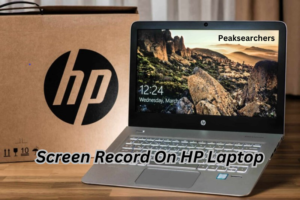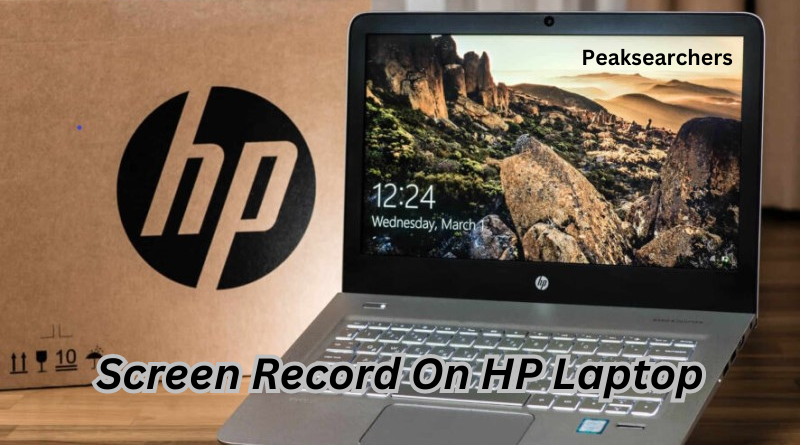How To Screen Record On HP Laptop? A Comprehensive Guide
Welcome to our comprehensive guide on how to screen record on an HP laptop. Screen recording is an invaluable tool for various purposes, such as creating tutorials, capturing important moments in videos, or demonstrating software functionality. In this article, we will walk you through the step-by-step process of screen recording on your HP laptop, ensuring you can effortlessly capture your screen activity. Let’s dive right in!

1. Understanding the Importance of Screen Recording
Screen recording has become increasingly popular due to its versatility and practicality. It allows you to visually communicate complex processes, share knowledge, and engage with your audience effectively. Whether you are a content creator, educator, or business professional, screen recording can significantly enhance your ability to convey information.
2. Exploring the Built-in Screen Recording Tools on HP Laptops
HP laptops come equipped with powerful built-in screen recording tools that simplify the process. To access these tools, follow these simple steps:
- Open the application or screen you want to record.
- Locate and press the “Windows key + G” on your keyboard to open the Game Bar.
- In the Game Bar overlay, click on the “Capture” button, represented by a circle within a square icon.
- Choose the desired recording mode: “Capture Specific Window,” “Capture Area,” or “Capture Full Screen.”
- Click the “Start Recording” button or press the “Windows key + Alt + R” to initiate the screen recording.
- Once you have finished recording, press the “Windows key + Alt + R” again or click the stop button on the Game Bar overlay.
3. Installing Third-Party Screen Recording Software
While the built-in tools offer convenience, you may prefer more advanced features and customization options. In such cases, installing third-party screen recording software is a viable solution. Here are a few highly recommended options:
- OBS Studio: A versatile and free open-source software that supports screen recording, streaming, and video editing.
- Camtasia: A feature-rich screen recording and video editing software that offers a user-friendly interface and professional-grade capabilities.
- Bandicam: Known for its minimalistic design and excellent performance, Bandicam is ideal for gamers and professionals alike.
4. Configuring Screen Recording Settings
Before starting your screen recording, it’s essential to configure the settings according to your preferences. To do this, follow these steps:
- Open the screen recording software of your choice.
- Navigate to the settings or preferences menu.
- Adjust parameters such as video resolution, frame rate, audio sources, and file formats based on your requirements.
- Save the settings to ensure they are applied for future screen recording sessions.
5. Capturing Your Screen Activity
Now that your HP laptop is equipped with the necessary tools and settings, let’s delve into the actual screen recording process. Follow these steps to capture your screen activity:
- Launch the screen recording software.
- Choose the appropriate recording mode: full screen, specific window, or custom area.
- Select the audio sources you want to include (system audio, microphone, or both).
- Click the “Record” button to start the screen recording.
- Perform the actions or present the content you wish to capture.
- Press the designated stop button to conclude the recording.
6. Editing and Enhancing Your Screen Recordings
After recording your screen activity, you might want to edit and enhance the resulting video. Editing software provides a range of features to refine your recordings and create a polished final product. Consider these popular options for post-recording editing:
- Adobe Premiere Pro: A professional-grade software offering advanced editing capabilities and extensive effects libraries.
- Filmora: A user-friendly video editing tool suitable for beginners, providing essential editing functions and pre-built effects.
- DaVinci Resolve: A comprehensive editing suite known for its powerful color correction tools and multi-camera editing capabilities.
7. Exporting and Sharing Your Screen Recordings
Once you have finalized your edited screen recording, it’s time to export and share it with your desired audience. Follow these general steps to complete the process:
- Open your chosen video editing software.
- Navigate to the export or render settings.
- Select the desired output format, resolution, and compression settings.
- Specify the destination folder for your exported video.
- Click the “Export” or “Render” button to initiate the export process.
- Once exported, you can share your screen recording via various platforms, such as YouTube, Vimeo, or your own website.
8. Tips and Tricks for Optimal Screen Recording
To ensure your screen recordings are of the highest quality, consider implementing the following tips and tricks:
- Close unnecessary applications and background processes to minimize system resource usage.
- Use a high-quality microphone or headset for improved audio clarity.
- Utilize keyboard shortcuts for streamlined recording and editing workflows.
- Plan your recording sessions and create an outline to maintain a structured flow of information.
- Regularly update your screen recording software to access the latest features and bug fixes.
Also Read: How To Connect Docking Station To Laptop? A Comprehensive Guide
9. Additional Tips for Optimizing Screen Recordings
To further enhance the quality and effectiveness of your screen recordings, consider implementing these additional tips:
a) Plan and Outline Your Content: Before starting the screen recording, spend some time planning the structure and flow of your content. Creating an outline or script will help you present information in a clear and organized manner, minimizing the need for excessive edits.
b) Use Annotations and Callouts: Screen recording software often includes annotation and callout features that allow you to highlight or emphasize certain areas of the screen. Utilize these tools to draw attention to important elements, provide additional context, or guide viewers’ focus.
c) Capture High-Quality Audio: Good audio quality is essential for a professional screen recording. Invest in a quality microphone or headset to ensure clear and crisp sound. Test the audio settings and levels before starting the recording to avoid any audio-related issues.
d) Utilize Keyboard Shortcuts: Keyboard shortcuts can significantly streamline your screen recording process. Familiarize yourself with the shortcuts specific to your chosen screen recording software to initiate, pause, resume, or stop recordings efficiently.
e) Optimize Video Settings: Depending on your intended use and platform, it’s crucial to optimize video settings such as resolution, frame rate, and aspect ratio. Consider the requirements and limitations of the platform where you plan to share your screen recordings to ensure compatibility and the best viewing experience.
f) Provide Context and Narration: While capturing your screen activity, remember to provide context and narrate your actions. Explain what you are doing, why you are doing it, and any relevant information that enhances understanding. This narration adds value to your screen recordings and engages your audience more effectively.
g) Optimize Video Editing Techniques: If you choose to edit your screen recordings, familiarize yourself with video editing techniques to improve the overall quality of your videos. Learn how to remove unnecessary segments, add transitions, incorporate text overlays, and optimize the visual appeal of your recordings.
10. Frequently Asked Questions (FAQs)
Q: Can I record my screen without any additional software on my HP laptop?
A: Yes, HP laptops offer built-in screen recording tools accessible through the Game Bar. However, for more advanced features and customization options, third-party software is recommended.
Q: Can I record specific windows or areas of my screen instead of the entire screen?
A: Absolutely! The built-in Game Bar and third-party software allow you to choose between capturing the full screen, specific windows, or custom areas according to your needs.
Q: How can I reduce the file size of my screen recordings without compromising quality?
A: To reduce file size, consider adjusting settings such as video resolution, frame rate, and compression settings. Finding the right balance between quality and file size is crucial.
Also Read: How To Connect Galaxy Buds To Laptop? A Comprehensive Guide
11. Conclusion
Screen recording on an HP laptop is a valuable skill that empowers users to visually communicate and share information effectively.
In this comprehensive guide, we explored the built-in screen recording tools, installation of third-party software, configuring settings, capturing screen activity, editing recordings, exporting and sharing videos, and provided valuable tips and tricks.
By following these steps, you’ll be well-equipped to create professional screen recordings and elevate your content creation capabilities. Happy recording!


